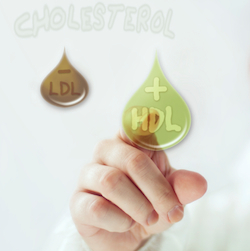Metabolic syndrome (MetSyn) is a multifaceted combination of cardiovascular disease risk  factors and co-morbidities that include abdominal obesity, elevated triglycerides, mildly elevated blood pressure and fasting glucose, and low HDL-cholesterol. Disagreements remain as to whether MetSyn risk factors act synergistically or independently. However the alterations in plasma triglycerides (TG) and cholesterol define the risk factors for cardiovascular disease. Beyond diet and exercise changes, the primary method to reduce cardio risk are statins, which has limitations in that TG and HDL remain the same but LDL-C is reduced, a dyslipidemia that is not always present in MetSyn.
factors and co-morbidities that include abdominal obesity, elevated triglycerides, mildly elevated blood pressure and fasting glucose, and low HDL-cholesterol. Disagreements remain as to whether MetSyn risk factors act synergistically or independently. However the alterations in plasma triglycerides (TG) and cholesterol define the risk factors for cardiovascular disease. Beyond diet and exercise changes, the primary method to reduce cardio risk are statins, which has limitations in that TG and HDL remain the same but LDL-C is reduced, a dyslipidemia that is not always present in MetSyn.
Could Omega-3 fatty acids play a role in addressing MetSyn? This study, Abnormal lipoprotein oxylipins in metabolic syndrome and partial correction by omega-3 fatty acids, published in Prostaglandins, Leukotrienes and Essential Fatty Acids, reviews the mechanisms by which Omega-3 fatty acids may indeed play a role in reducing the cardiovascular risks of MetSyn.
Abstract
Metabolic syndrome (MetSyn) is characterized by chronic inflammation which mediates the associated high risk for cardiovascular and other diseases. Oxylipins are a superclass of lipid mediators with potent bioactivities in inflammation, vascular biology, and more. While their role as locally produced agents is appreciated, most oxylipins in plasma are found in lipoproteins suggesting defective regulation of inflammation could be mediated by the elevated VLDL and low HDL levels characteristic of MetSyn. The objective was to compare the oxylipin composition of VLDL, LDL, and HDL in 14 optimally healthy individuals and 31 MetSyn patients, and then to determine the effects of treating MetSyn subjects with 4 g/day of prescription omega-3 fatty acids (P-OM3) on lipoprotein oxylipin profiles.
The study compared oxylipin compositions of healthy (14) and MetSyn (31) subjects followed by randomization and assignment to 4 g/d P-OM3 for 16 weeks using LC/MS/MS. Compared to healthy subjects, MetSyn is characterized by abnormalities of (1) pro-inflammatory, arachidonate-derived oxylipins from the lipoxygenase pathway in HDL; and (2) oxylipins mostly not derived from arachidonate in VLDL. P-OM3 treatment corrected many components of these abnormalities, reducing the burden of inflammatory mediators within peripherally circulating lipoproteins that could interfere with, or enhance, local effectors of inflammatory stress.
Study Findings
1. Study subjects included 13 healthy controls and 31 with MetSyn. The recruitment criteria focused on triglyceride and HDL levels and BMI, however the subjects with MetSyn were additionally insulin resistant and had high blood pressure.
2. P-OM3 therapy induced profound changes in some, but not all lipoprotein oxylipins; in some cases treatment resulted in oxylipin patterns that were similar to those in healthy subjects. P-OM3 induced changes (Supplemental Table 6) were found in three of eleven clusters.
3. This study sought to understand the abnormalities in lipid signaling metabolites that are present in MetSyn and whether those can be normalized by P-OM3. Clinically, the dyslipidemia of MetSyn is derived from the VLDL-TG:HDL axis [26]. Although P-OM3 partially resolves the VLDL elevation [14] it profoundly affects the fatty acid composition of all lipoproteins [27].
4. Based on findings, MetSyn patients are characterized by elevated HDL and VLDL LOX derived metabolites and reduced fatty acid epoxides in VLDL. P-OM3 treatment resulted in the correction of some, but not all, of these MetSyn deficits.
Conclusion
The abnormalities in discrete lipoprotein oxylipin clusters in MetSyn suggest a novel molecular explanation for the risks and outcomes associated with it. Since at least one abnormality of MetSyn lipoproteins is an enrichment with inflammatory oxylipins, it suggests these molecules may be delivered via lipoprotein receptors or lipases to tissues involved in the atherosclerotic process. Partial correction of the abnormality by P-OM3 provides a feasible explanation for the reduction in inflammatory stress by omega-3 fatty acids.
The study authors conclude that MetSyn is associated with a disruption of lipoprotein oxylipin patterns consistent with greater inflammatory stress, and the partial correction of these dysoxylipinemias by treatment with omega-3 fatty acids could explain some of their beneficial effects.
Shearer GC, Borkowski K, Puumala SL, Harris WS, Pedersen TL, Newman JW. Abnormal lipoprotein oxylipins in metabolic syndrome and partial correction by omega-3 fatty acids. Prostaglandins Leukot Essent Fatty Acids. 2018 Jan;128:1-10. doi: 10.1016/j.plefa.2017.10.006





